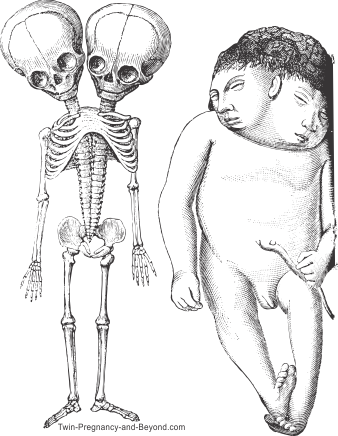Rare and Unusual Types of Twins

There are a few rare and unusual types of twins that you may not have heard of. Most people know about identical and fraternal twins, and even conjoined twins. But have you ever heard of chimera twins?
In this interesting article we will discuss the different types of twinning that can occur that many people don't know about or don't know the facts about.
Scroll down for more...You are sure to learn something new!
A List of Rare and Unusual Types of Twins
- Semi-identical Twins
This type of twinning is so rare that only two cases have ever been discovered and some experts say we may never see another one.
In 2007 scientists revealed the world's first case of semi-identical twins who were born in the United States, but remain anonymous.
It is said that they were the result of two sperm fertilizing one single egg. The egg then divided to form two separate embryos with genes from each sperm making the twins identical on their mother's side, but with only half their genes on their father's side.
More recently, in 2015, the second case was discovered with testing while the twins were still in utero. These boy/girl twins were the first semi-identical or sesquizygotic twins born in Australia.
The following video does a great job of explaining this extremely rare type of sesquizygotic twinning:
- Boy/Girl Monozygotic Twins
Some people mistakenly refer to this type of twinning as "identical twins of different genders". However, we have found that the more accurate medical term is "monozygotic twins of different genders".
The term monozygotic describes twin pairs that develop from only one zygote that then splits to form two embryos. These types of twins are always the same gender, unless a very rare mutation happens in male twin pairs where one loses a Y chromosome and develops as a female.
The female in this case would be described as having Turner's Syndrome, in which case she will not mature naturally because of missing genetic material. There are varying degrees of Turner's Syndrome and each female will develop differently.
- Polar Body or Half Identical Twins
While this interesting type of twinning is still just a theory, it does provide food for thought.
The prediction is that a woman ovulates a single egg that splits and is THEN fertilized by two separate sperm resulting in "half-identical" twins.
The twins in this case would both have identical DNA from the mother, but varying DNA structures from the father's side.
"Half-identical" twins are not to be confused with "semi-identical" twins, in which case the egg does not split, but is fertilized by two different sperm. There has been at least one reported and confirmed case of this, while half-identical twins are still just a concept.

Recent Articles
-
Double Duty Log Book For Twins - An easy way to keep track
Apr 11, 24 06:18 PM
Our Double Duty Log Book for Twins will help you stay on schedule, keep track of feedings and more. Save your sanity and get it all done with a twin log sheet that really works! -
37 weeks+4days and feeling huge
Sep 14, 23 12:12 PM
I am expecting a boy and girl.❤️ My belly is massive,it’s 3 times bigger than my previous pregnancy.My bum has also gotten bigger(My hubby loves it)!I -
Foods Babies Should Avoid
Jan 12, 23 06:30 PM
Foods Babies Should Avoid is a part of our feeding twins guide




Comments or Questions?
Join the conversation. We love to hear from our readers!